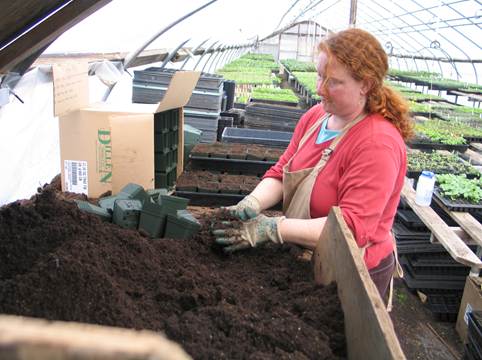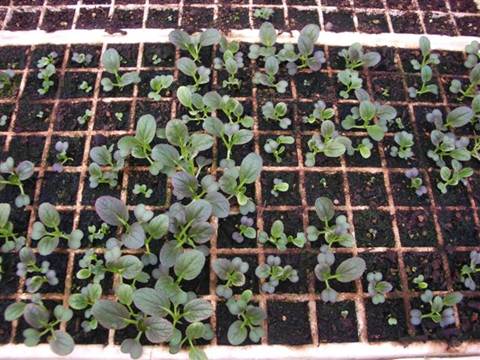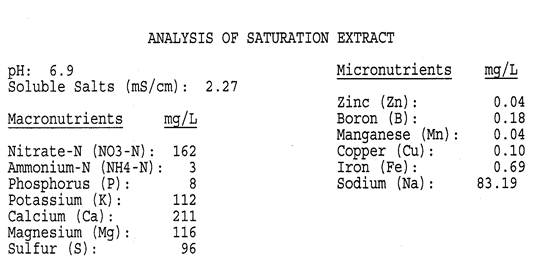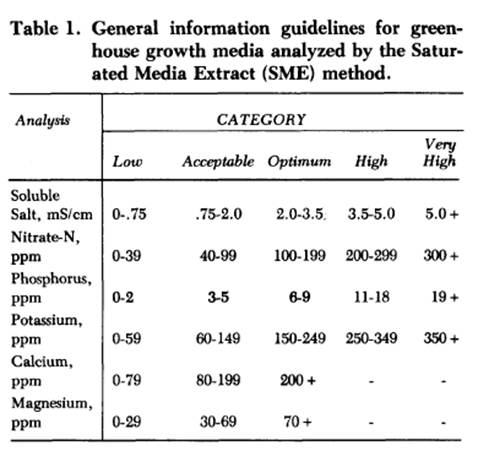
POTTING MIXES FOR ORGANIC GROWERS
Vern Grubinger, vegetable and berry
specialist
University of Vermont Extension
Soilless
potting mixes have long been used for greenhouse production of bedding plants, vegetable
transplants and container-grown ornamentals. By avoiding the use of topsoil,
the risk pathogenic microorganisms in this media may be reduced, avoiding
problems with diseases like damping-off. In addition, topsoil is relatively
heavy and dense so it can contribute to poor aeration and drainage in a potting
mix. Soil-less mixes should be formulated to have optimal physical and chemical
properties that promote germination and healthy seedling growth.
Qualities
of a good mix. Poor
performance in a potting mix is costly, since greenhouse space is expensive and
so is having to toss out some seedlings or replant entirely. Optimal mix
characteristics include the right density and porosity to provide good aeration
and also good water holding capacity; proper pH and enough available nutrients
to get plants off to a good start, and the absence of excess salts and plant
pathogens. On organic farms, the mix must not contain any prohibited
ingredients.
Organic
vs. conventional mixes. Generally speaking, all soilless potting mixes contain a
‘base’ ingredient, usually sphagnum peat, or sometime coir. These provide a
good physical environment for root growth but are relatively inert in terms of
nutrient content and biological activity. Other materials may be added to
improve drainage, adjust density and/or alter water holding capacity, such as
perlite, vermiculite or builder’s sand. Ground limestone may be needed to raise
the pH. Fertilizers are added to provide
available nutrients and obviously that’s where conventional and organic mixes
differ. In addition, organic mixes typically contain mature compost to provide
slow release nutrients and contribute to good physical and biological
conditions for plant growth, whereas conventional mixes rarely contain compost.
Issues
with compost in potting mix. In some ways, compost is like snowflakes – no two batches of compost
are exactly alike. So while compost usually adds value to a potting mix, it can
also add a measure of uncertainty about performance that is not the case with
conventional mixes. Immature compost in particular can harm seedlings by
releasing ammonia, or tying up nitrogen, or stunting growth because of organic
acids that have not fully decomposed. To avoid these problems it is important
to use only mature compost, and to buy it from a reputable source or to carefully
make your own using a consistent supply of high quality ingredients.

It's a good idea to keep organic
potting mixes warm and moist for a week or two before planting into them. That
allows microbial activity to kick in, and can reduce potential potting mix
problems by allowing excess ammonium or organic acids to dissipate.
Compost
is rarely used by itself as a potting medium. Compost alone does not have the
optimal water holding characteristics, and soluble salt levels may be higher
than optimal for potting mix. Plus, high quality compost can be relatively
expensive so it makes sense to dilute it with other ingredients like peat.
Organic potting mixes are typically made with 20% to 50% compost by volume,
depending on the type of crop that will be grown in the mix, the container
size, and the growing conditions.
Common
potting mix ingredients. Sphagnum peat moss is a stable organic material that holds 15 to 30
times its weight in water and decomposes very slowly. It contains about 1% N
but little is released because it breaks down so slowly. It has a pH of about 4
so lime must be added to the mix to along with sphagnum peat, at the rate of
8.5 lb. per cubic yard of peat to neutralize the acidity.
Coir
comes from coconut husks and is a waste product of the coco fiber industry. It
has physical properties much like peat but a higher pH of about 6. It holds up
to nine times its weight in water. It can have a high salt content.
Limestone
is either calcitic (high calcium) or dolomitic (high magnesium; both are used
to increase the pH of a mix but dolomite is preferable for supplying both Ca
and Mg.
Vermiculite
helps hold water and fertilizer in the potting mix, and it also contains some
calcium and magnesium. It has a pH near neutral. Vermiculite comes in different
grades; medium grade is usually used for starting seeds, a coarse grade may be used
for larger plants.
Perlite
is a volcanic rock that has been heated and expanded. It is lightweight,
sterile and has a neutral pH. It can be used to improve reduce the weight of a
potting mix and increase its aeration and drainage.
Coarse
washed sand also called builder’s sand can be used to add air space to the
potting mix and increase its weight. It has a neutral pH and provides almost no
fertility to plants. Sand may be used when added weight is needed for growing
tall or top heavy plants that might fall over if grown in a lightweight mix.
Fertilizers
for organic mixes.
In some cases, compost can provide adequate amounts of nutrients for transplant
production but usually some fertilizer is added to the mix, especially if
larger plants are to be produced or if small cell sizes are used that will
require relatively high levels of available nutrients in order to sustain plant
growth over time. Common organic fertilizers to provide phosphorus include bone
meal, bone char or rock phosphate; potassium can be provided by potassium sulfate,
sul-po-mag or greensand; magnesium can come from epsom salts or sul-po-mag. In
some cases a blended fertilizer may be used such as pelletized chicken manure
compost but such materials are usually reserved for field use rather than
potting mix due to their slower nutrient availability.
Nitrogen
availability.
Assuring sufficient N in a form plants can use is often a concern with organic
potting mix formulations, as N release may be quite variable depending on the compost
that’s used and the extent to which it is source of nitrogen. Most organic
potting mixes are supplemented with fertilizers sources such as blood meal, crab
meal, fish meal, or plant meals like alfalfa or soybean to provide additional N
to feed plants for several weeks or months. Note that Chilean nitrate is
expected to be prohibited for use in organic production sometime in 2012.
Some
growers water with fish emulsion or other soluble organic N fertilizers to keep
their transplants ‘growing on’ if a mix has run out of available nitrogen. Re-potting
some plants, like tomato seedlings, into fresh mix is another way to keep them
growing well.
When
using blood meal, partially composted manure or poultry-manure based fertilizer
be aware that these high N sources need some time to allow for microbial
activity start breaking the organic forms of N and drive them to nitrate (the
process called mineralization). If planted into too soon, when first wetted and
just starting to break down, these materials may give off ammonia, organic
acids and other compounds that can damage germinating seeds and young plants.
It is best to moisten the potting mix at least a week or two before you plant
into it, making sure it stays warm and allowing time for phytotoxic compounds
to dissipate.

Many things can lead to poor
germination, including a mix with excess salts, improper pH, unfinished
compost, or nutrient imbalances. Old seeds,
improper watering, and root disease can also be to blame.
Avoiding
performance problems.
While many growers have had success with compost-based potting mixes, the
performance of such mixes, whether commercially produced or homemade, has
sometimes been inconsistent. In the worst cases, growers have experienced
significant financial loss due to poor seedling growth associated with a
problem mix. Poor seedling growth in compost-based mixes can result from low
levels of available nutrients, high levels of soluble salts, excessive density
of the mix, and/or the lingering presence of the harmful byproducts of initial
decomposition mentioned above. In some cases the problem is not due to the mix
but to management issues, like cold temperatures, improper watering or root
disease.
Test
your mix. It is a
very good idea to test your organic potting mix well in advance of using it.
Send a sample to a soil test lab at a land grant university or at a private
company that specializes in horticulture. Do not request a regular field soil
test, since potting mixes differ from field soil; they are much higher in
organic matter and usually much higher in available nutrient content. A potting
soil test will also measure soluble salts (electrical conductivity) and nitrogen
in the nitrate and ammonium forms, which a field soil test doesn’t.

Growers should use the
low cost saturated media extract test (aslo called greenhouse media test), to
get data on the pH, soluble salt, and nutrient levels of their potting mix well
in advance of planting. Here are the results of one sample.
The
soil test to use for potting mixes is the saturated media extract (SME), also
called a greenhouse media test or soilless media test. Unlike field soil tests
that extract nutrients with weak acid solutions, the SME sample is mixed with
distilled water at a standard dilution and then analyzed. Since different labs
may use different dilutions, stick with one lab. To get an accurate reading, be
sure that the potting mix has been moist and warm for at least a week prior to
sampling. Most labs require a pint of mix to work with, and turnaround time is
similar to a regular soil test, a week or two. It’s a good idea to test each
batch of potting mix, and to be able to compare results from mixes that performed
well to those that didn’t. The cost is low, about $15 or $20 per SME sample.

The information in this table was
developed at Michigan State University in the 1980's. Keep in mind that some
crops such as herbs are more sensitive to salts and require lower nutrient
levels for good growth than other crops like tomatoes which can tolerate more
salts and will respond to higher nutrient levels.
‘Bioassays’
are another way to test the quality of a potting mix. All you have to do is sow
some fast-growing crops in the mix several weeks before you plan to use it.
Cress, oats, beans are just a few to consider. Some growers also like to test
their mixes with slower-growing crops. Onions can be useful for bioassays as
they seem to require a very high quality mix for good germination and growth.
It makes sense to include any key crops that you grow as part of your bioassay.
Compare
potting mixes. Without a side by side trial, it’s hard to
evaluate the relative performance of your current potting mix. So even if you
have one you like, plant a few trays of the same seeds using another potting
mix brand or recipe. It may surprise you to see how poorly your plants do next
to a different formulation.
If
things go wrong. Go ahead and submit sample(s) for SME testing;
better late than never. Having this data in hand is part of the process of
elimination to identify the problem. Is the pH off? Are soluble salts too high?
Is there sufficient available N for plant growth? Once you have that data in hand, contact your
potting mix supplier and ask if others growers have reported problems. A good
supplier will appreciate communication from their customers, and be able to
provide technical advice.
“Buying
potting mix from a company like ours means you are buying into a network of
organic growers” says Karl Hammer, owner of Vermont Compost Company. “That has great
value for both buyers and sellers of the product. Sometimes I get a call about
a problem but when I follow up with other growers using the same mix to grow the
same crops I find that they have no issues. Then it’s probably related to a
greenhouse management practice. In fact, ninety percent of the problems I see
have to do with over-watering in short daylight and cold weather conditions.
Overwatering cools the growing medium, reducing microbial activity and root
growth, and it can leach out available nutrients. It’s much better keep your
growing medium on the dry side, and if possible, provide bottom heat. Over-the-top
watering by hand with cold water creates a lot of plant growth problems in
organic potting mixes.”
For
information on organic potting mixes, including a number of recipes developed
by farmers, see the eOrganic web site: http://www.extension.org/pages/20982/organic-potting-mix-basics
revised 2-1-12
RETURN TO VERMONT VEGETABLE AND
BERRY PAGE
![]()



